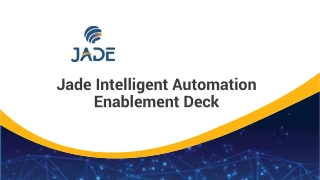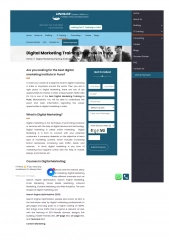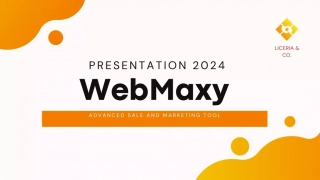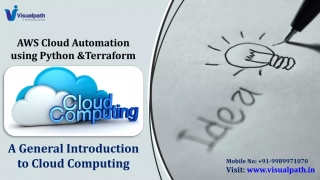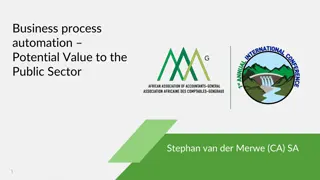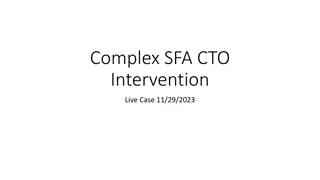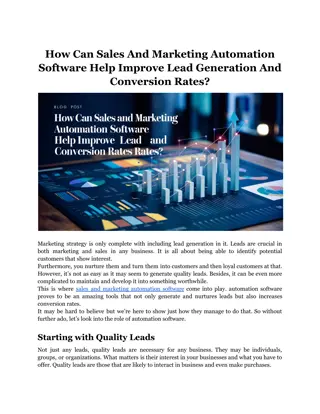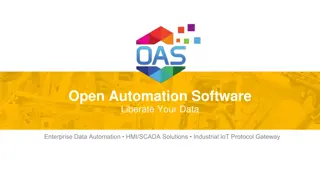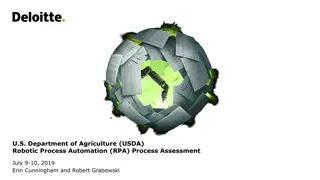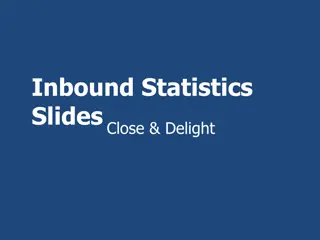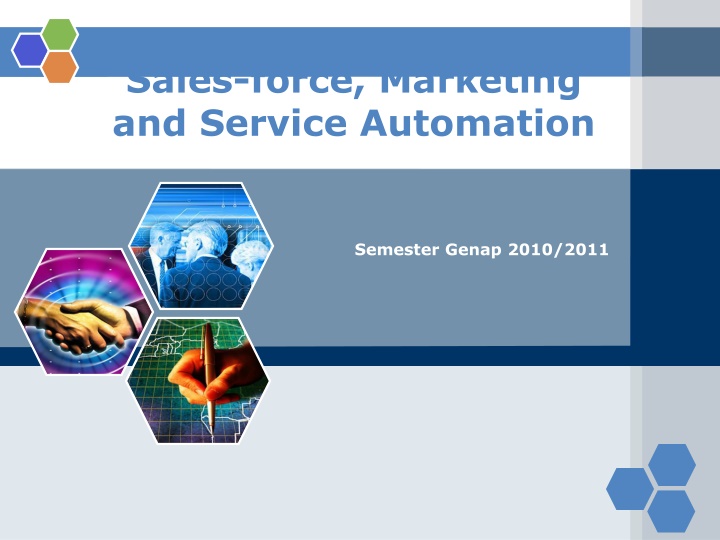
Sales Force Automation and Marketing Strategies
Explore the world of Sales Force Automation and Marketing strategies, focusing on customer lifecycle, recruitment, retention, and growing customer value. Learn about key technologies, software solutions, and functionalities in the realm of SFA.
Download Presentation

Please find below an Image/Link to download the presentation.
The content on the website is provided AS IS for your information and personal use only. It may not be sold, licensed, or shared on other websites without obtaining consent from the author. If you encounter any issues during the download, it is possible that the publisher has removed the file from their server.
You are allowed to download the files provided on this website for personal or commercial use, subject to the condition that they are used lawfully. All files are the property of their respective owners.
The content on the website is provided AS IS for your information and personal use only. It may not be sold, licensed, or shared on other websites without obtaining consent from the author.
E N D
Presentation Transcript
Sales-force, Marketing and Service Automation Semester Genap 2010/2011
Learning Objectives Understand the meaning of the terms customer life cycle Define the strategies that can be used to recruit new customers Understand how to select which customers to target for retention Identify several strategies for growing customer value
Sales Force Automation (SFA)
Sales Force Automation Definition The application of computerised technologies to support sales people and sales management in the achievement of their work-related objectives
Key Technologies for SFA SFA hardware includes desktop, laptop and handheld devices, and contact/call centre technology SFA software comprises both point solutions that are designed to assist in a single area of selling or sales management, and integrated solutions that offer a range of functionality
SFA Software Solutions SFA specialists SFA as part of CRM suite Onyx SFA as part of Enterprise suite Oracle Selectica EzRoute Pivotal SAP Salesnet Salesforce.com Epicor CallWizard SalesLogix Deltek Selltech ACCPAC Fourth Shift CyberForms NetCRM Intentia
SFA Functionality account management pipeline management activity management product encyclopaedias contact management product configuration contract management product visualization document management proposal generation event management quotation management incentive management sales forecasting lead management territory management opportunity management work-flow engineering order management
Account Management Offers sales reps and managers a complete view of the customer relationship including contacts, contact history, completed transactions, current orders, shipments, enquiries, service history, opportunities, and quotations This allows sales reps and account managers to keep track of all their obligations in respect of every account for which they are responsible, whether this is an opportunity to be closed, an order or a service enquiry
Activity Management Keeps sales reps and managers aware of all activities, whether complete or pending, related to an account, contact, or opportunity, by establishing to-do lists, setting priorities, monitoring progress and programming alerts Activities include preparation of quotations, scheduling of sales calls and following up enquiries, for example
Contact Management Contact management functionality includes tools for building, sharing and updating contact lists, making appointments, time setting, and task, event and contact tracking Contact list data includes names, phone numbers, addresses, preference data, and email addresses for people and companies, as well as a history of in- bound and out-bound communications
Contract Management Contract management functionality enables reps and managers to create, track, progress, accelerate, monitor and control contracts with customers Contract management helps manage a contract's lifespan by shortening approval cycles for contracts, renewing contracts sooner, and reducing administrative costs The software may use security controls to ensure only approved people have access to contracts
Document Management Companies generate and use many documents as they sell to customers - brochures, product specifications, price lists, competitive comparisons, and templates for preparing quotations, for example Document management software allows companies to manage these documents, keep them current and ensure that they are available to reps and managers when needed
Event Management Enables reps and managers to plan, implement, control and evaluate events such as conferences, seminars, trade shows, exhibitions and webinars, whether run solo or jointly with customers or other partners
Incentive Management An issue for sales managers who use commissions to lift, direct and reward sales reps efforts In many companies, commissions are calculated using stand-alone spreadsheets
Lead Management Allows companies to create, assign and track sales leads User-defined rules allow leads to be allocated to reps and account managers on the basis of role, territory, product expertise or other variables Lead management allows for more equitable workload distribution across a sales team, and uses security controls to ensure that reps can only access their own leads
Opportunity Management A record of a potential sale or any other type of revenue generation Opportunity management software enables reps and managers to create an opportunity record in the database, and monitor progress against a predefined selling methodology
Order Management Order management functionality allows reps to convert quotations and estimates into orders once a customer has agreed to buy Order management software may include a quotation engine, a pricing module, and a product configurator With visibility through a portal, the customer, rep and manager has access to the same, up-to-date order information
Pipeline Management The process of managing the entire sales cycle from: identifying prospects estimating sales potential managing leads forecasting sales initiating and maintaining customer relationships right through to closure A well-defined sales pipeline helps minimize lost opportunities and breakdowns in the sales process
Proposal Generation Proposal generation software allows users to create customized proposals for customers Users draw from a database of information to create proposals which, typically, are composed of several parts, some of which are customized: cover page and letter, introduction, objectives, products, product features, services, prices, specifications, pictures, drawings, people, experience, resumes, references, approach, schedule, organization, scope of work, and appendices.
Quotation Management Quotation management software allows reps and managers to quote for opportunities The software allows users to create, edit, approve, and produce costed, customized, proposals quickly and reliably Some vendors enable users to create multimedia proposals with audio, animation and video
Territory Management Territory management software allows sales managers to create, adjust and balance sales territories, so that sales reps have equivalent workloads and/or opportunities Some territory management applications come with a territory management methodology which users can follow when establishing sales territories Some applications link to geographic mapping, or geo-demographic, software The software enables companies to match sales coverage to market opportunity, create sales territory hierarchies (cities, states, regions) and reduce the cost of selling by reducing travel time Call cycle scheduling, calendaring and lead management is often enabled by the software
Workflow Engineering Workflow engineering software is useful for designing sales-related processes, such as the lead management process, and the event management process It can even be used to design the selling process itself the series of steps that a sales rep must follow in shifting a prospect from initial awareness to the close
Examples of SFA Reports cost-to-serve sales cycles customer profitability share of market lead conversion share of wallet pipeline progress sales person productivity quotation performance win-loss rates
Benefits for SFA Stakeholders Salespeople: shorter sales cycles, more closing opportunities, higher win rates Sales managers: improved salesperson productivity, improved customer relations, accurate reporting, reduced cost-of-sales Senior management: accelerated cash flow, increased sales revenue, market share growth, improved profitability
Motivations for Implementing SFA Motivation % of sample reporting 72 Improve efficiencies Improve customer contact 44 Increase sales 33 Reduce costs 26 Improve accuracy 21
SFA will enhance performance when.. Sales people find that SFA is easy to use Sales people find the technology useful because it fits their roles well Availability of appropriate-to-task SFA training Users have accurate expectations about what SFA will deliver Users have a positive attitude towards innovation and technology Availability of user support after roll out, for example, a help desk Involvement of user groups including sales reps and managers during project planning and technology selection Deployment of a multi-disciplinary team in the project planning phases Senior management support for SFA
Marketing Automation (MA) Definition The application of computerised technologies to support marketers and marketing management in the achievement of their work-related objectives
Benefits from Marketing Automation Enhanced marketing efficiency Greater marketing productivity More effective marketing Enhanced responsiveness Improved marketing intelligence Improved customer experience
Functionality Offered by MA Software Asset management Campaign management Customer segmentation Direct mail campaign management Document management Market segmentation Marketing analytics Marketing optimisation Marketing performance management Marketing resource management Partner marketing Product life-cycle management Search engine optimisation Telemarketing Trigger marketing Web analytics Workflow engineering Email campaign management Enterprise marketing management Event-based marketing Internet marketing Keyword marketing Lead generation Loyalty management
Asset Management Enables companies to identify and track the assets that customers purchase, license, use, install, or download Assets can be either tangible, intangible or blended
Campaign Management Automates the processes involved in planning, implementing, measuring, and learning from communication programs targeted at prospects or customers The key elements of campaign management software are workflow, segmentation and targeting, personalization, execution, measurement, modelling and reporting
Customer Segmentation The practice of partitioning customers into homogenous subsets so that each subset can be addressed as a unique marketing audience This is the foundation of customer portfolio management
Direct Mail Campaign Management A specific form of campaign management in which the communication medium is direct mail Direct mail has many applications including lead generation, lead conversion, building awareness, up-selling and cross-selling, customer retention, database building or image enhancement Important contributors to direct mail success are the list, the creative execution, the offer, and the timing
Email Campaign Management Email campaign management is a specific form of campaign management in which the communication medium is email Email is cheap, easy to use and ubiquitous
Enterprise Marketing Management Encompasses the business strategy, process automation and technologies required to effectively operate a marketing department, align resources, execute customer-centric strategies and improve marketing performance It is best-suited for large organizations with 50 or more people in marketing This includes functionality for campaign management, lead management, MRM [marketing resource management] and analytics
Event-based Marketing Occurs when an event triggers a communication or offer Event-based campaigns are usually initiated by customer behaviours or contextual conditions
Internet Marketing The process of creating value by building and maintaining online customer relationships
Keyword Marketing The practice of generating website traffic from internet users who have entered keywords into search engines such as Google, Yahoo!, AOL, Ask.com and Live search (formerly MSN)
Lead Generation An important marketing objective, particularly in business-to-business contexts Sales people challenged to grow the numbers of customers served need to be presented with high quality leads for follow-up Marketers can deploy campaigns, events, seminars, Webinars and other tactics to generate the leads
Loyalty Management Loyalty management functionality allows organisations to develop and operate loyalty management programs The development of customer loyalty is a goal of many CRM programs The availability of loyalty management applications is a direct response to this need Loyalty, or frequency, programs are important to several constituencies the brand owner who operates the program, the member who collects and redeems credits, and the channel partner who transacts with the member
Marketing Analytics The application of mathematical and statistical processes to marketing problems Marketing analytics can be used to explore, describe and explain
Marketing Optimization Marketing optimization software allows companies to select an overall goal, such as sales or profit margin maximization, and specify all of the constraints of a marketing campaign strategy The software then determines which customers should get which offer through which channel to ensure the campaign objectives are met
Marketing Performance Management Marketing performance management (MPM) software enables companies to measure their marketing performance though analysis and reports, and improve outcomes over time through closed- loop marketing Senior management is progressively becoming more demanding that marketers be accountable for their expenditure, and MPM helps marketers meet that expectation MPM, which is typically focussed on analysis of marketing tactics such as events and campaigns, is routinely built into most MA applications
Marketing Resource Management Marketing resource management applications consist of a range of automated tools that enable marketers to manage their marketing processes and assets more effectively, and to work at greater speed and with improved control MRM toolkits may include modules for : Marketing planning and budgeting, New product launch, Marketing event calendaring, Event planning and registration, Project management, Campaign planning, Collateral production, proofing and approval, Digital asset management, including brands, trademarks, logos and collateral, Expense and budget management, Time management, Media buying, and Procurement
Partner Marketing Partner marketing solutions enable companies to coordinate and work collaboratively with channel partners and others Partner marketing solutions are used to manage processes such as: partner qualification and sign up development of joint business plans and objectives cooperative advertising and promotions lead management co-branding of collateral and point-of-sale materials measuring partner performance partner training administration of marketing funds specialist partner incentive schemes
Product Life-cycle Management Product life-cycle management (PLM) applications help marketers manage life cycle stages effectively and profitably PLM software solutions facilitate collaborative intra- and extra-enterprise engineering, product development, and improved management of projects, product portfolios, documents, and quality PLM applications can provide a single source of all product-related information to use in the innovation, design, engineering, feasibility, launch and market development processes
Telemarketing Telemarketing is the use of the telephone to identify and qualify prospects, and to sell and service the needs of customers Telemarketing takes two forms: inbound (calls from customers) outbound (calls to customers) a blended function with agents both making and receiving calls Telemarketing is widely employed in both B2C and B2B environments, but is subject to legislative control due to its intrusive nature



